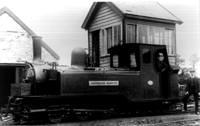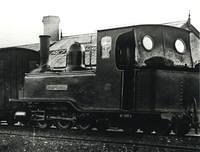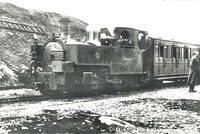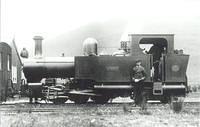History of the WHR: 1b - NWNGR Stock
© Copyright 1990 Alun Turner & the Welsh Highland Railway Ltd.
North Wales Narrow Gauge Railways Stock
Locomotives 'Snowdon Ranger' and 'Moel Tryfan'
Five locomotives were built for the North Wales Narrow Gauge Railways. Three of these were of the Single Fairlie type. The Vulcan Foundry built two 0-6-4 Fairlie locomotives, Snowdon Ranger and Moel Tryfan which carried the numbers 739 and 738 respectively. These were from original drawings signed 'C.E. Spooner per G. Percival Spooner'. They were completed in 1875 and used to work the main line when it opened in 1877. These two locomotives were very similar in design to the four coupled engine introduced by G.P. Spooner on the Ffestiniog Railway about a year later.
Both were fitted with Stephenson valve gear, cylinders 8 ½ x 14 ins., side tanks, solid disc wheels 2 ft 6 ins diameter and inside bearings throughout. The trailing bogie had 1 ft 7 ins diameter wheels. The outline was plain and neat, with a stovepipe chimney and a round-topped brass-cased dome. The boiler barrel was just over 2 ft in diameter and 8 ft long between tube plates. It contained 104 tubes of 1½ in diameter. There was a single Salter safety valve on the middle of the boiler barrel. The total heating surface was 361.6 sq ft. The grate area was 6 sq ft which gave 60.26 sq ft of heating surface per sq ft of grate. Working pressure was 140 lb per sq inch. The power bogie was pivoted under a cast iron saddle riveted to the underside of the boiler, and steam was received at the valve chest through a pendulum pipe, pivoted immediately below the smokebox.
Tank capacity was 359 gallons and coal capacity was 10 cwt. The weight of each locomotive in working order was 14 ½ tons, of which 10 ½ tons rested on the six-coupled wheels, and 4 tons on the trailing bogie. The total wheelbase was 14 ft 11 ½ in, to which the leading bogie contributed 6 ft and the trailing bogie 3 ft 6 in.
As built, no continuous brake appears to have been fitted, but both locomotives underwent repairs at the works of Davies and Metcalfe Ltd, of Romiley near Stockport, in 1903. The Westinghouse brake, with which both engines were equipped in later years, may well have been fitted then. The Westinghouse compressor was installed in the cab, and the reservoirs beneath the footplate on each side of the cab floor. Both locomotives received new boilers and a heavy overhaul during their time at Davies and Metcalfe Ltd.
In 1908, Snowdon Ranger was sent to the Hunslet Engine Co. Ltd, of Leeds, for repair. Moel Tryfan was retubed in 1913. By 1917 both locomotives were in very poor condition but the railway could not afford replacements. The solution was novel although not unique in narrow gauge history: they built a new locomotive out of the best parts of the two engines. This locomotive utilised the frames of Snowdon Ranger and the boiler of Moel Tryfan . What they could not use and was not worth keeping as spares was cut up for scrap. This hybrid locomotive retained the name Moel Tryfan and continued in service on the main line. In 1924 it was cut down for working through the tunnels on the Ffestiniog Railway. Finally it was taken into the Ffestiniog Railway Boston Lodge Works in 1936 for boiler repairs but the work was never carried out. Dismantled some years later, its remains could be seen scattered around the yard until 1955 when the parts were finally scrapped.
What became of Snowdon Ranger and Moel Tryfan is described here.
Locomotive 'Beddgelert'
For the Bryngwyn branch, an outside framed 0-6-4 tank engine built in 1878 by the Hunslet Engine Co. Ltd. and named Beddgelert was purchased. It was a larger locomotive than the two Fairlie types and was fitted with a saddle tank, flared top chimney with a polished-brass bell-mouthed casing enclosing the dome and Salter safety valves. Four square sandboxes were mounted panier fashion, two on each side of the tank. Legend has it that Beddgelert came equipped with a boiler on the incline principle to counteract the ruling gradient of 1 in 39 to 1 in 48 on the Bryngwyn branch. Photographs of Beddgelert (of which few survived as it seldom worked the main line where most of the photographs of this period were taken) are not clear. The original drawings do not show the boiler to be inclined but all accounts from those who visited the line support the incline theory.
Beddgelert had 2 ft 6 in coupled wheels and 1 ft 10 in bogie wheels, 10 x 16 in cylinders, 416 sq ft of heating surface and a grate area of 7.9 sq ft. The total wheelbase was 15 ft 11 in, of which 6 ft 2 in was rigid. With 450 gallons in the tank the engine weighed 17 tons, of which 12 tons rested on the coupled wheels. The locomotive worked at 160 lb per sq inch boiler pressure.
Locomotive 'Russell'
Until 1906, these three locomotives ran all the North Wales Narrow Gauge Railways services. The Fairlies, as already mentioned, were rebuilt, but Beddgelert was scrapped in 1906 after a new 2-6-2 tank engine Russell , built by the Hunslet Engine Co. Ltd., was acquired. This locomotive was in fact purchased by the Portmadoc, Beddgelert and South Snowdon Railway especially to run on the North Wales Narrow Gauge Railways. The full circumstances of this unusual purchase will become clearer later. Noticeable features of the new locomotive were the Walschaerts valve gear, outside frames and long side tanks. The round-topped dome had a bright brass casing and the chimney a flared top. Between the chimney and the dome a cannister shaped sandbox was mounted originally, although this was later removed. Cylinders were 10 ¾ x 15 in. The diameter of the coupled wheels was 2 ft 4 in, the leading and trailing wheels 1 ft 6 in diameter. The total heating surface was 381 sq ft and the grate area 6.25 sq ft. The tanks had a capacity of 440 gallons and the engine weighed 20 tons in working order.
The full story of Russell, still running on the Welsh Highland today, is to be found in " Russell, the Story of a Locomotive " available from the Railway Shop. Russell is described further and illustrated here.
Locomotive 'Gowrie'
The last engine was obtained in September 1908. It was another single boiler Fairlie type 0-6-4 tank locomotive, apparently the last of this type of locomotive to be built for use in the British Isles. It was built by the Hunslet Engine Co. Ltd. Originially this locomotive ran without a name, but eventuall it was named Gowrie, after Gowrie Colquhoun Aicheson, the Manager of the Portmadoc, Beddgelert and South Snowdon Railway Co. This engine differed considerably from the two Vulcan Foundry engines in outward appearance. The boiler, 2 ft 5 in in diameter by 8 ft 10 in long, had a raised round-top firebox. The side tanks stopped short over the driving axle. There was no footplate round the front end. The rear bogie had outside frames. It had 9¼ x 14 in cylinders, the coupled wheels had a diameter of 2 ft 4½ in on a wheelbase of 5 ft 6 in. The trailing bogie had wheels of 1 ft 10 in diameter and the total wheelbase was 14 ft. The boiler contained 65 brass tubes of 1½ in outside diameter providing 252 sq ft of heating surface. The copper firebox had a grate area of 5 sq ft and a heating surface of 30 sq ft. The working pressure was 160 lb per sq in. Steam distribution was by Walschaerts valve gear. The tanks held 400 gallons of water and the bunker was 1 ton 2 cwt of coal. The weight in working order was 18 tons, of which 11 tons 6 cwt rested on the coupled wheels.
Coaches
The North Wales Narrow Gauge painted its locomotives brown (also described variously as red-brown or Midland red) of a similar shade to the old North British colour, lined out in black and yellow. Carriages had a two colour finish resembling the former Lancashire and Yorkshire Railway. The first passenger coaches were six-wheelers with Cleminson Trucks, as used on the Manx Northern Railway and on the Sothwold Railway. They were roofed and fully glazed above the waistline, weighing 4½ tons each and were 30 ft long, with seating for 42 passengers. Subsequently the closed compartment or semi-open type of coach was adopted and each compartment seated 8 passengers in the third class and 6 passengers in the first class.
See also a further description of the Gladstone coach and the buffet coach.





